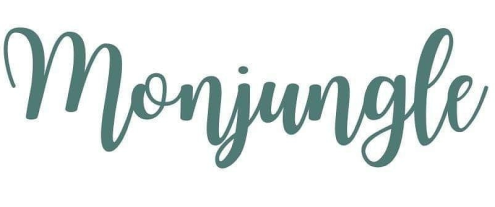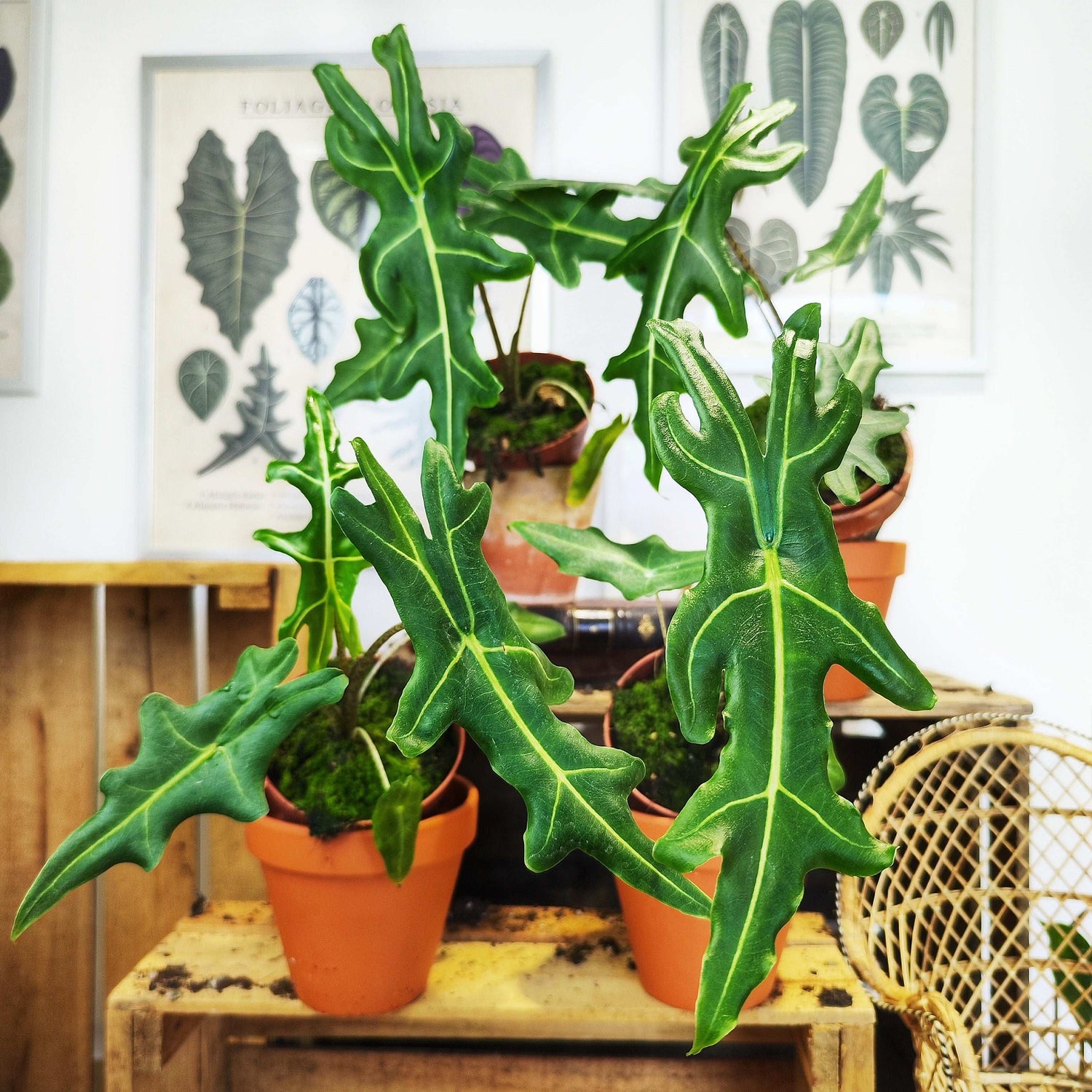Sort by:
Alocasia Jacklyn
🪴 Alocasia Jacklyn is a rare and sought-after variety known for its deeply cut leaves with dark veins. A true collector's item.
Care instructions
- Light: Moderate to bright indirect light
- Watering: Keep the soil slightly moist
- Temperature: 18-28°C
- Difficulty: High
Benefits
🌬️ Natural depollutant
Origin
Indonesia
Alocasia Longiloba Silver🌿
You will receive a cutting with approximately 2 or 3 leaves, measuring 25cm.
An Alocasia that impresses with its size and silvery foliage with metallic reflections, for a lush jungle effect.
🌞 Ideal conditions
- Light : Bright light without direct sunlight
- Watering : Keep the substrate moist
- Humidity : Ideally >60%
- Height : Up to 1m indoors
🌴 Origin
Native to the tropical forests of Southeast Asia. Its arrow-shaped leaves can reach 60cm in length.
Alocasia Macrorrhiza Splash – A tropical touch with a unique design 🪴
Transform your home with Alocasia Macrorrhiza Splash , a stunning tropical plant with large foliage splashed with unique creamy white patterns 🌿. Ideal for fans of graphic plants, it instantly catches the eye with its large, heart-shaped leaves, naturally marbled like a modern work of art.
Why choose Alocasia Splash? 💡
- Remarkable aesthetics: its large variegated leaves create a spectacular visual effect 🎨.
- Rare and trendy plant: highly sought after for contemporary interiors and urban jungles.
- Benefits: It purifies the ambient air while adding a touch of tropical freshness 🌬️.
Care instructions 🧑🌾
- Light: Prefers bright, indirect light. Avoid direct sunlight, which can burn its leaves ☀️❌.
- Watering: Keep the substrate slightly moist, without overwatering. Let the top layer dry between waterings 💧.
- Humidity: Enjoys a humid atmosphere. Spray regularly or place near a humidifier 💦.
- Temperature: between 18 and 25°C. Protect from the cold and drafts ❄️🚫.
- Difficulty level: moderate – suitable for both experienced amateurs and curious enthusiasts 🔍.
Origin and particularities 🌍
Native to the tropical forests of Southeast Asia, Alocasia Macrorrhiza is an understory plant that thrives in warmth and humidity. The Splash variety is distinguished by its rare variegated foliage, the result of natural mutation or horticultural hybridization.
With its majestic shape and unique patterns, this Alocasia is perfect as a centerpiece in a bright living room or a tropical veranda 🌸.
MyJungle Council 🌱
Place it in a simple planter to enhance its colors, and remember to turn the pot regularly for harmonious growth 😉.
Alocasia Melo – A rare plant with an inimitable style
Alocasia Melo Dark , also known as Jewel Alocasia, is a valuable houseplant for lovers of exotic foliage. Native to Southeast Asia, this variety is distinguished by its large, thick, almost rigid leaves with a leathery texture and a dark green, almost graphite hue.
Sculptural and graphic foliage
Its unique foliage immediately catches the eye: pronounced veins, dark reflections, and a decidedly designer look. It's an ideal plant for adding a contemporary and luxurious touch to your interior.
Care instructions
- Light: Prefers bright light without direct sunlight. Tolerates bright partial shade.
- Watering: Water moderately, allowing the substrate to dry slightly between waterings. Beware of overwatering.
- Temperature: Enjoy a constant temperature between 18°C and 26°C. Avoid drafts.
- Humidity: Likes a humid atmosphere. Spray regularly or place near a humidifier.
- Maintenance level: Moderate. Recommended for enthusiasts with some experience with tropical plants.
The benefits of Alocasia Melo
In addition to being a real decorative asset, the Alocasia Melo helps purify the ambient air. It invites relaxation and escape thanks to its tropical and imposing appearance.
Why choose Alocasia Melo at MonJungle?
- Plant carefully selected for its quality and health
- Secure delivery in protective packaging
- Maintenance sheet included for worry-free support
Alocasia Ninja 🖤
A rare alocasia with deep black foliage and a velvety texture, bringing sophistication and mystery to your collection.
🌑 Optimal conditions
- Light : Medium indirect
- Humidity : >60% recommended
- Temperature : Minimum 18°C
- Substrate : Light and well-draining
✨ Rarity
Its velvety leaves literally absorb light. Native to the tropical rainforests of Asia.
Alocasia Pink Dragon – Tropical elegance in your home 🌿
Alocasia Pink Dragon , also known as Elephant Ear , is a rare and sought-after houseplant. With its unique pink stems and dark green foliage with pronounced veins, it adds an exotic and refined touch to your decor 🪴.
Why choose Alocasia Pink Dragon? 🌸
- Spectacular foliage : large, ribbed leaves with dark purple undersides.
- Elegant pink stems that contrast beautifully with the foliage.
- Tropical origin : from Southeast Asia, it brings a chic jungle atmosphere to your interior.
- Benefits : Purifies the air and creates a calming atmosphere 🌿.
Care instructions 🧑🌾
- Light 💡: Place it in a bright room, without direct, burning sunlight.
- Watering 💧: Once a week in summer, once or twice a month in winter. Let the soil dry slightly between waterings.
- Humidity 🌫️: appreciates a humid atmosphere, ideally near other plants or with a tray of clay balls.
- Temperature 🌡️: ideal between 18 and 22°C, never drop below 10°C.
- Maintenance : repot every 1 to 2 years, liquid fertilizer for green plants from March to October.
- Difficulty ⭐⭐✰✰✰: requires a little attention, perfect for passionate amateurs.
An essential decorative asset 🪴
With its elegant silhouette and contrasting colors, the Alocasia Pink Dragon is a collectible houseplant that attracts all eyes. It can reach up to 1.20 meters in height, becoming a centerpiece in your living room or office.
Alocasia Portei – An XXL jungle touch for your interior
Alocasia Portei , also known as the "Giant Elephant Ear," is a spectacular tropical plant with large, ribbed, and cut leaves that instantly bring an exotic feel to any home. Its sculptural, rich green foliage makes it a true statement plant .
Care instructions
- Light: Prefers bright, indirect light. Avoid direct sunlight, which can burn the leaves.
- Watering: Water regularly to keep the soil slightly moist, but not overly so. Reduce watering in winter.
- Temperature: Between 18°C and 25°C. It does not tolerate cold or drafts. 🌡️
- Humidity: Likes a humid atmosphere. Mist regularly or place near a humidifier.
- Difficulty: Medium. A little fickle, but rewarding!
Special features & benefits
- Huge, deeply lobed leaves for an immediate jungle effect. 🌴
- Purifies ambient air, perfect for large living or working spaces.
- Decorative plant with a strong visual impact, ideal as a centerpiece.
Origin & natural habitat
Native to Southeast Asia, Alocasia Portei grows naturally in warm, humid tropical forests, so it thrives in similar conditions indoors.

Alocasia Reginula 'Ninja' (S) – Mini Alocasia black & compact
Alocasia Reginula 'Ninja' (S) – Mini Alocasia black & compact
Alocasia Ninja 🥷
A small version of Alocasia Reginula with velvety black foliage. Compact size, perfect for shelves or terrariums.
Interview
- Light: indirect
- Humidity: high
Alocasia scabriuscula
🌿 Alocasia scabriuscula captivates with its deep green foliage and unique ribbed texture. Compact and decorative, it fits easily into any interior.
Care instructions
- Light: Bright indirect light
- Watering: Slightly damp soil, without excess
- Temperature: 18-25°C
- Difficulty: Medium
Special features
🍃 Marked veins, dense and elegant shape
Origin
Native to Southeast Asia
A precious and sparkling Alocasia 🌿
Alocasia Scaphochlamys Scintillans 'Ooi' is a rare and valuable houseplant native to the rainforests of Malaysia. Prized for its velvety, shimmering deep green leaves and unique appearance, this variety stands out for its almost jewel-like appearance. ✨
Why you'll love it 💚
- Spectacular foliage: oval leaves with pronounced veins and a silky texture that capture the light. 🌱
- Exceptional plant: rare variety, perfect for collectors or lovers of unique plants. 🧑🌾
- Guaranteed tropical vibes: it brings a touch of jungle chic to any room. 🪴
Care instructions 🌞💧
- Light: Bright indirect light. Avoid direct sunlight, which can burn its leaves. 💡
- Watering: Keep the substrate slightly moist. Allow the surface of the soil to dry between waterings. 💧
- Temperature: Ideal between 18°C and 26°C. Avoid drafts and temperatures below 15°C. 🌡️
- Humidity: It loves a humid atmosphere. Mist it regularly or place it near a humidifier. 💦
- Difficulty: Moderate. Recommended for experienced or enthusiastic amateurs. 🌿
Benefits and uses 🧘♂️
Beyond its aesthetic appeal, Alocasia 'Ooi' helps purify the air and creates a calming and inspiring space . Perfect for an office, living room or conservatory, it quickly becomes the star of your indoor jungle. 🌸
Origin and particularity 🌏
This variety originates from the tropical forests of Southeast Asia. Its rarity makes it a highly sought-after plant among collectors. It is cultivated for its exceptional ornamental qualities and decidedly graphic character.
























































